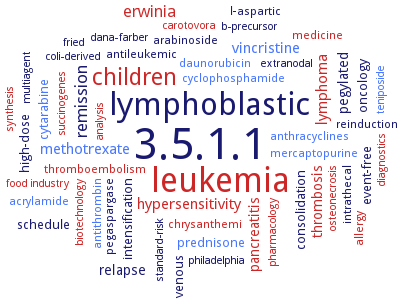3.5.1.1: asparaginase
This is an abbreviated version!
For detailed information about asparaginase, go to the full flat file.

Word Map on EC 3.5.1.1 
-
3.5.1.1
-
leukemia
-
lymphoblastic
-
children
-
remission
-
erwinia
-
hypersensitivity
-
methotrexate
-
lymphoma
-
vincristine
-
pegylated
-
relapse
-
pancreatitis
-
thrombosis
-
prednisone
-
high-dose
-
venous
-
oncology
-
event-free
-
schedule
-
cytarabine
-
consolidation
-
intensification
-
antileukemic
-
intrathecal
-
antithrombin
-
l-aspartic
-
chrysanthemi
-
anthracyclines
-
medicine
-
reinduction
-
cyclophosphamide
-
pegaspargase
-
thromboembolism
-
allergy
-
acrylamide
-
arabinoside
-
mercaptopurine
-
daunorubicin
-
osteonecrosis
-
analysis
-
philadelphia
-
extranodal
-
fried
-
b-precursor
-
succinogenes
-
standard-risk
-
synthesis
-
coli-derived
-
food industry
-
diagnostics
-
biotechnology
-
dana-farber
-
pharmacology
-
teniposide
-
carotovora
-
multiagent
- 3.5.1.1
- leukemia
- lymphoblastic
- children
-
remission
- erwinia
- hypersensitivity
- methotrexate
- lymphoma
- vincristine
-
pegylated
-
relapse
- pancreatitis
- thrombosis
- prednisone
-
high-dose
- venous
-
oncology
-
event-free
-
schedule
- cytarabine
-
consolidation
-
intensification
-
antileukemic
-
intrathecal
- antithrombin
-
l-aspartic
- chrysanthemi
- anthracyclines
- medicine
-
reinduction
- cyclophosphamide
-
pegaspargase
- thromboembolism
- allergy
- acrylamide
-
arabinoside
- mercaptopurine
- daunorubicin
- osteonecrosis
- analysis
-
philadelphia
-
extranodal
-
fried
-
b-precursor
- succinogenes
-
standard-risk
- synthesis
-
coli-derived
- food industry
- diagnostics
- biotechnology
-
dana-farber
- pharmacology
- teniposide
- carotovora
-
multiagent
Reaction
Synonyms
14270 ASNase, alpha-asparaginase, AnsA, ansA3, AnsB, ansZ, Asn, ASNase, ASNase1, ASNase3, ASP1, ASP3, asparaginase, asparaginase II, asparagine amidohydrolase, asparginase II, ASPG, ASPG II, ASPGA1, ASPGB1, ASRGL1, At3g16150, colaspase, crasnitin, DiAsp, EcAII, EcAIII, EcaL-ASNase, ECAR-LANS, elspar, ErA, Erwinase, glutaminase-free L-asparaginase, glutamine-(asparagin-)ase, HPA, L-ASNase, L-asparaginase, L-asparaginase 2, L-asparaginase I, L-asparaginase II, L-asparaginase III, L-asparaginase type II, L-asparaginase type III, L-asparaginase-I, L-asparaginase-II, L-asparagine amidohydrolase, L-asparagine amino hydrolase, L-asparagine aminohydrolase, leunase, PfA, PhA, potassium-dependent asparaginase, potassium-independent asparaginase, potassium-independent L-asparaginase, SAMN05216263_10744, SGR ASNase, type I L-asparaginase, type II L-asparaginase, Ypa


 results (
results ( results (
results ( top
top





